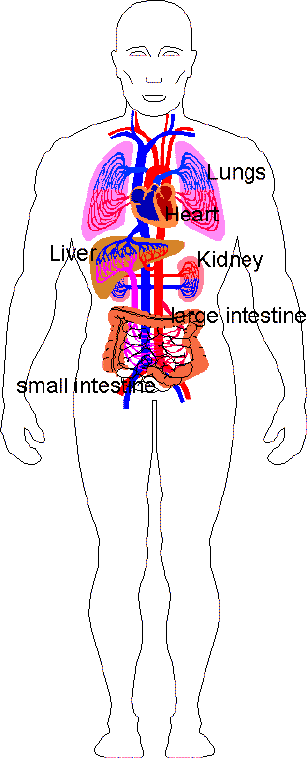We know that equations can be written in slope intercept form or standard form.
Let's quickly revisit standard form. Remember standard form is written:
To write in scientific notation, follow the form where N is a number between 1 and 10, but not 10 itself, and a is an integer (positive or negative number). You move the decimal point of a number until the new form is a number from 1 up to 10 ( N ), and then record the exponent ( a ) as the number of places the decimal point was moved. Let's say I had the fraction 1/2. Why isn't it writing. Let me make sure I get the right color here. Let's say I had the fraction 1/2. So graphically, if we to draw that, if I had a pie and I would have cut it into two pieces. That's the denominator there, 2. And then if I were to eat 1 of the 2 pieces I would have eaten 1/2 of this pie.
Ax +By= C
We can pretty easily translate an equation from slope intercept form into standard form. Let's look at an example.

Example 1: Rewriting Equations in Standard Form
Rewrite y = 2x - 6 in standard form.
Standard Form: Ax + By = C
This means that we want the variables (x & y) to be on the left-hand side and the constant (6) to be on the right-hand side.
When we move terms around, we do so exactly as we do when we solve equations! So, remember.. Whatever you do to one side of the equation, you must do to the other side!
Solution
That was a pretty easy example. We just need to remember that our lead coefficient should be POSITIVE!
Let's take a look at another example that involves fractions. There is one other rule that we must abide by when writing equations in standard form.
Equations that are written in standard form:
Ax + By = C
CANNOT contain fractions or decimals! A, B, and C MUST be integers!
Let's take a look at an example.
Write 26% As A Decimal

Example 1: Rewriting Equations in Standard Form
Rewrite y = 2x - 6 in standard form.
Standard Form: Ax + By = C
This means that we want the variables (x & y) to be on the left-hand side and the constant (6) to be on the right-hand side.
When we move terms around, we do so exactly as we do when we solve equations! So, remember.. Whatever you do to one side of the equation, you must do to the other side!
Solution
That was a pretty easy example. We just need to remember that our lead coefficient should be POSITIVE!
Let's take a look at another example that involves fractions. There is one other rule that we must abide by when writing equations in standard form.
Equations that are written in standard form:
Ax + By = C
CANNOT contain fractions or decimals! A, B, and C MUST be integers!
Let's take a look at an example.
Write 26% As A Decimal
Example 2: Standard Form Equations
Rewrite y = 1/2x + 4 in standard form.
We now know that standard form equations should not contain fractions. Therefore, let's first eliminate the fractions.
Since the only fraction is is 1/2, we can multiply all terms by the denominator (2) to eliminate the fraction.
Write 26% As A Fraction
Write 26/39 In Simplest Form
Solution
Now, let's look at an example that contains more than one fraction with different denominators.
Need More Help?
If you find that you need more examples or more practice problems, check out the Algebra Class E-course. You'll find additional examples on video, lots of practice problems with detailed solutions and little 'tips' to help you through!
Example 3: Eliminating Fractions
Rewrite y = 3/4x - 1/8 in standard form.
Our first step is to eliminate the fractions, but this becomes a little more difficult when the fractions have different denominators!
We need to find the least common multiple (LCM) for the two fractions and then multiply all terms by that number!
Solution
Slope intercept form is the more popular of the two forms for writing equations. However, you must be able to rewrite equations in both forms.
For standard form equations, just remember that the A, B, and C must be integers and A should not be negative. Rapidweaver 8 2 12.
- > >
Comments
We would love to hear what you have to say about this page!Need More Help With Your Algebra Studies?
Get access to hundreds of video examples and practice problems with your subscription!
Click here for more information on our affordable subscription options.
Not ready to subscribe? Register for our FREEPre-Algebra Refresher and Solving Equations Unit!
Sometimes when dividing there is something left over. It is called the remainder.
Example: There are 7 bones to share with 2 pups.
But 7 cannot be divided exactly into 2 groups,
so each pup gets 3 bones,
and there is 1 left over:
We say:
'7 divided by 2 equals 3 with a remainder of 1'
Date format creator 1 3 – date format creator software. And we write:
7 ÷ 2 = 3 R 1
As a Fraction
It is also possible to cut the remaining bone in half, so each pup gets 3 ½ bones:
7 ÷ 2 = 3 R 1 = 3 ½
'7 divided by 2 equals 3 remander 1 equals 3 and a half'
Play with the Idea
Try changing the values here .. sometimes there will be a remainder:
Check by Multiplying
If we look at it 'the other way around' we can check our answer:
2 × 3 + 1 = 7 Hr task timer 1 3.
'2 groups of 3, plus 1 extra, equals 7'
Another Example
19 cannot be divided exactly by 5. The closest we can get (without going over) is:
3 x 5 = 15
which is 4 less than 19.
So the answer of 19 ÷ 5 is:
19 ÷ 5 = 3 R 4
Check it by multiplying: 5 × 3 + 4 = 19
As a Fraction
We can also make a fraction with:
- the remainder on top, and
- the number you are dividing by on the bottom,
so we also have:
19 ÷ 5 = 3 R 4 = 3 4/5
